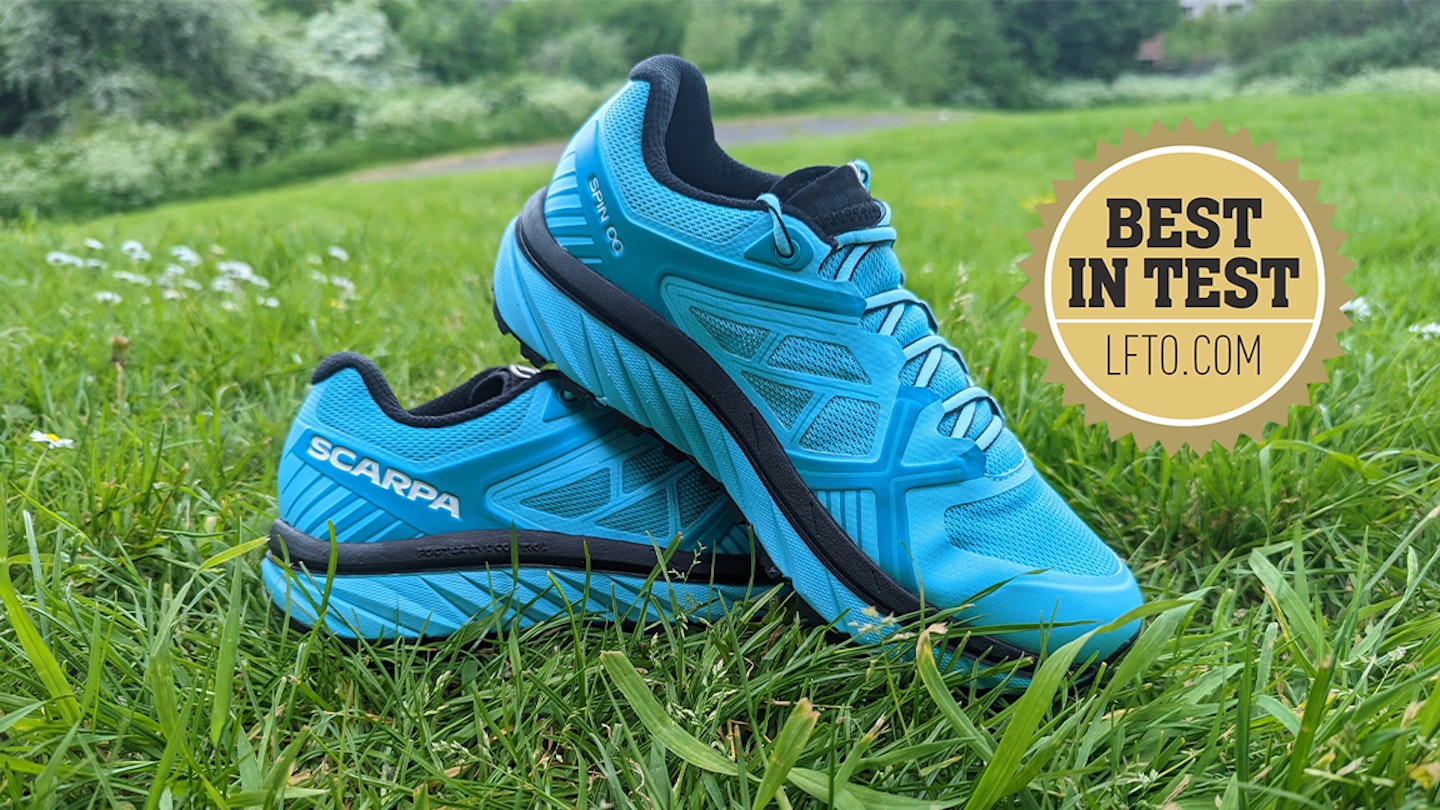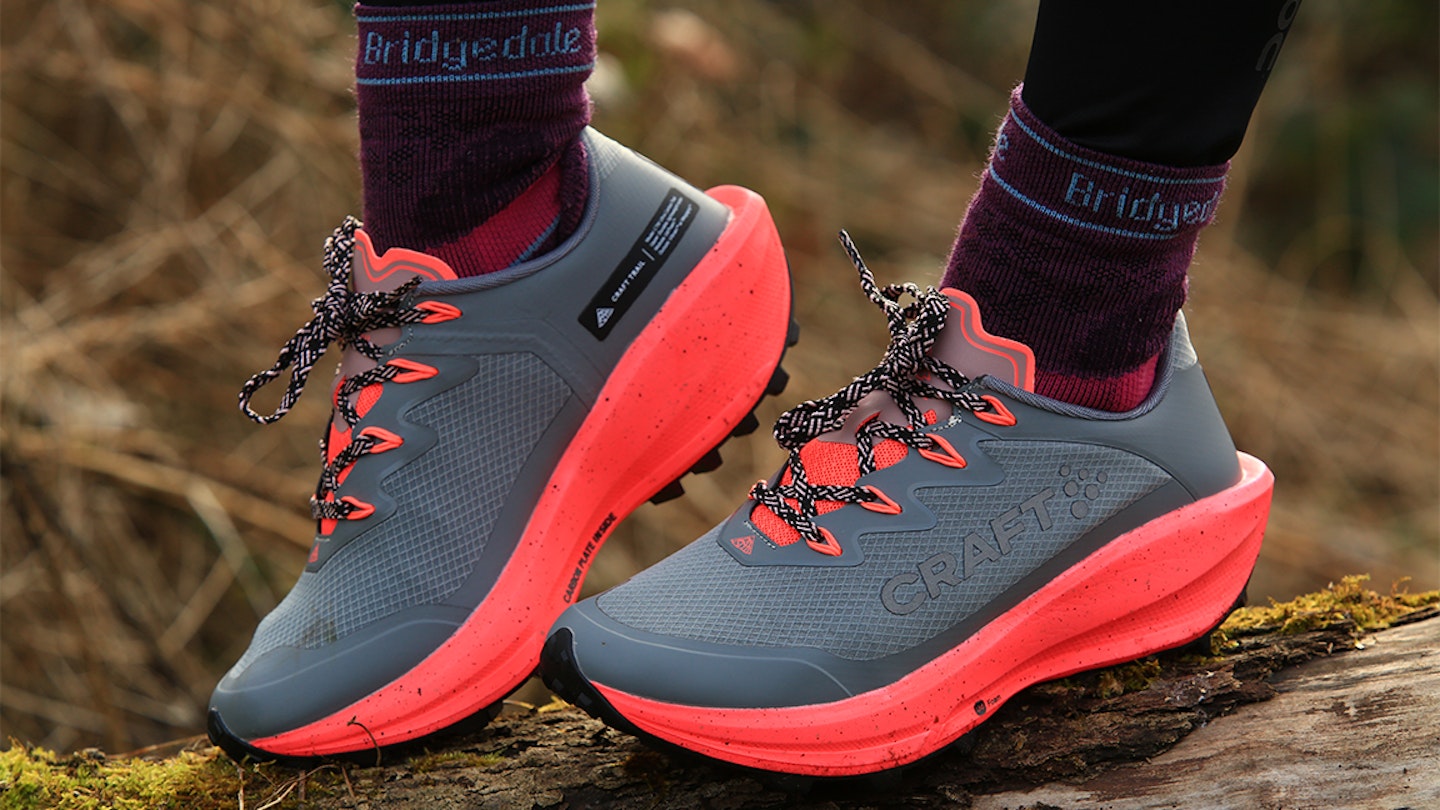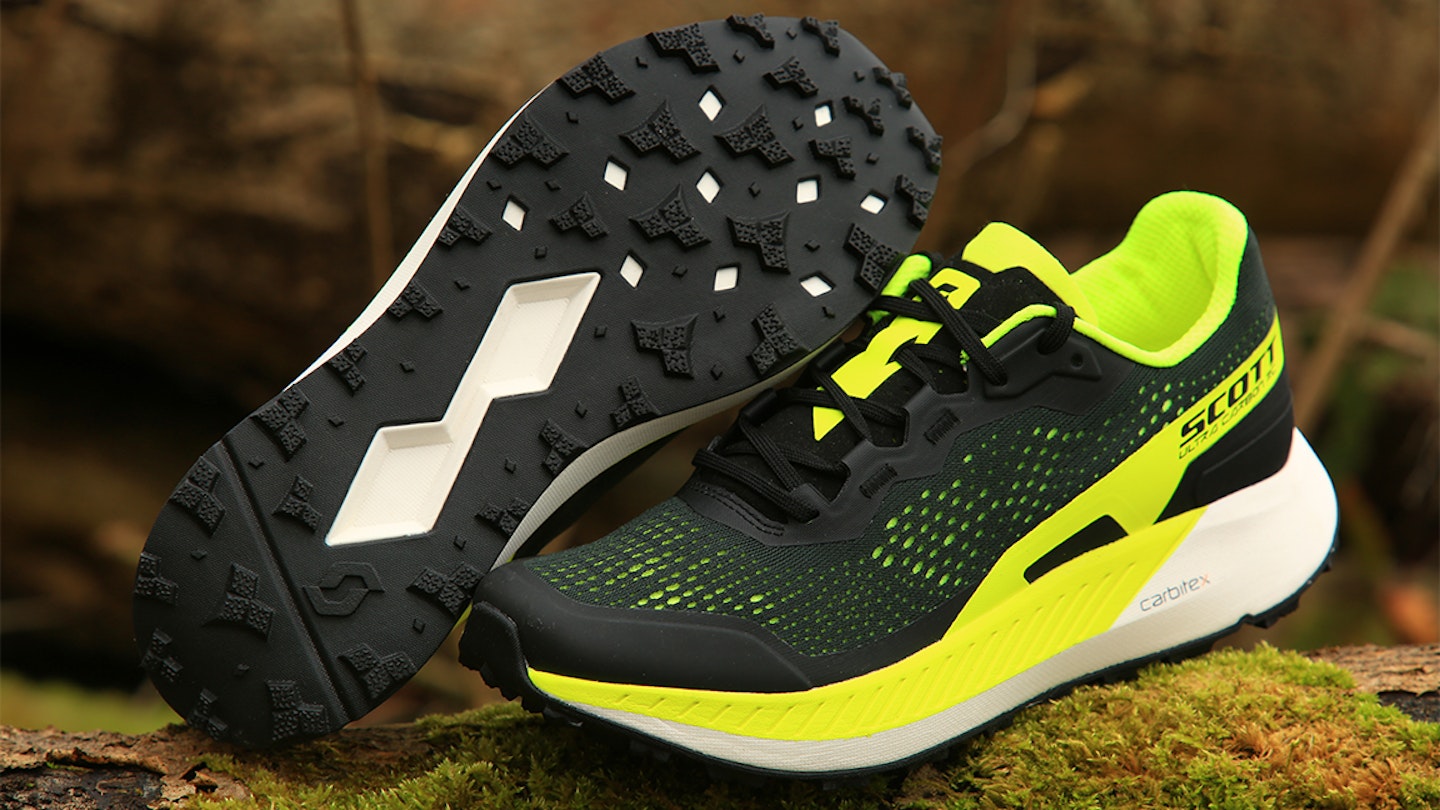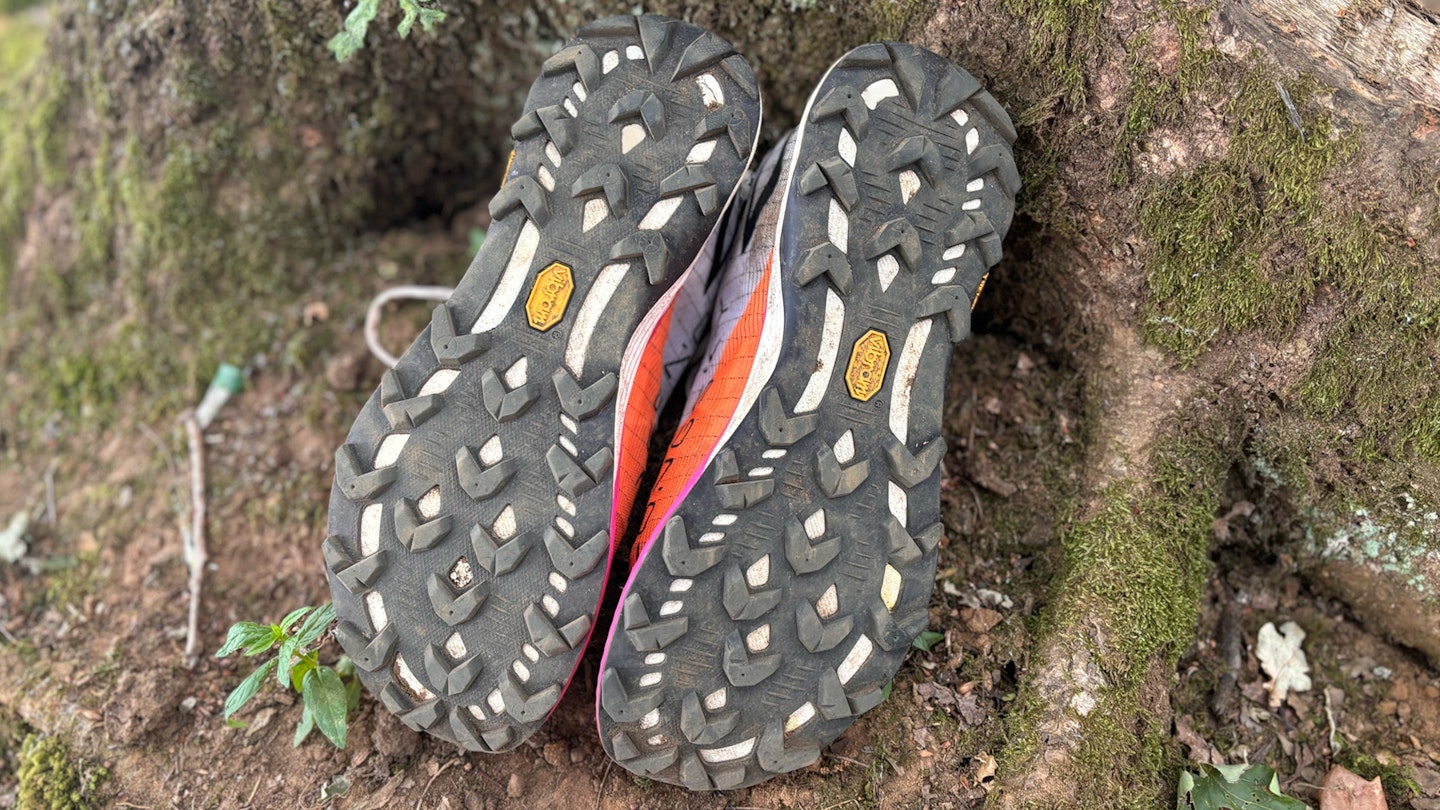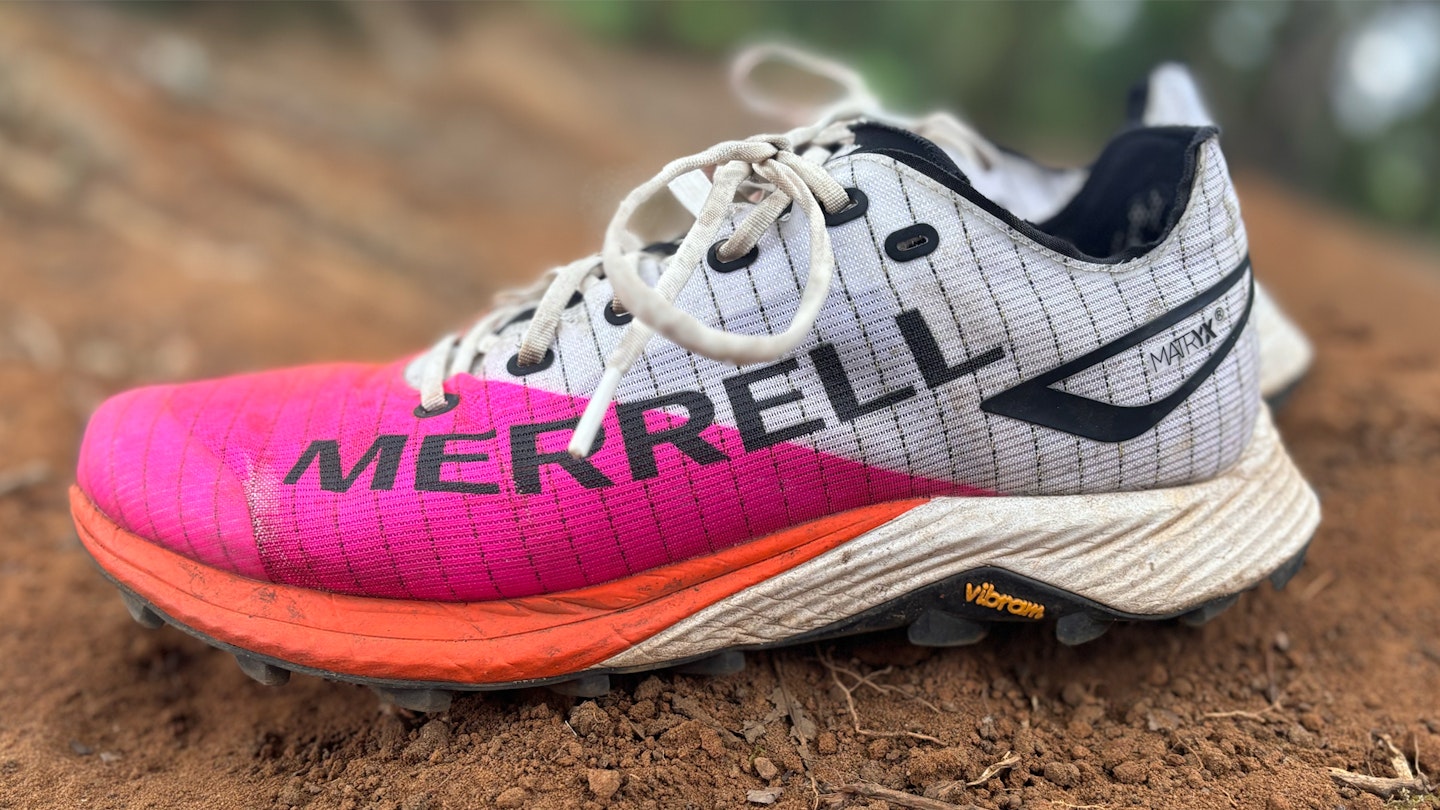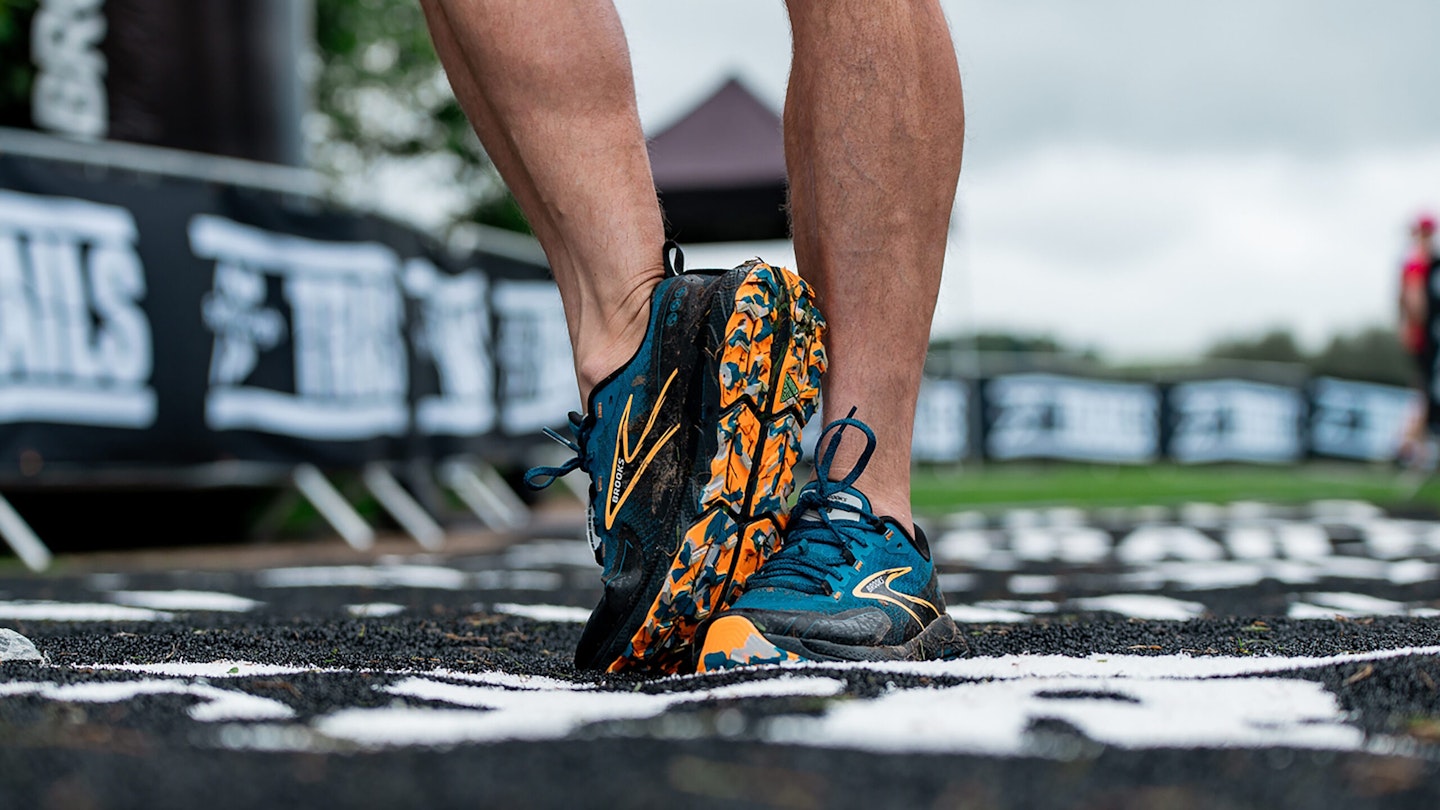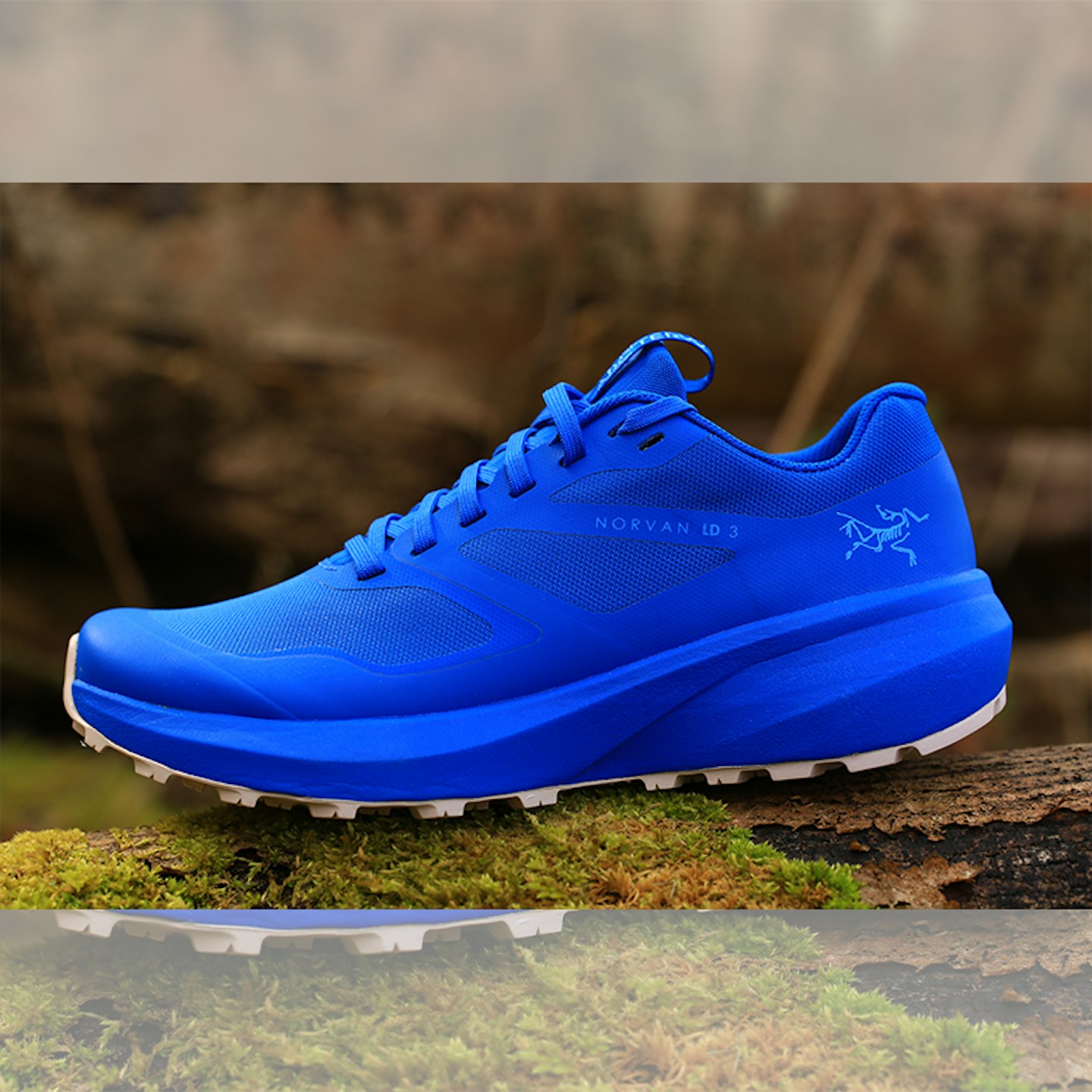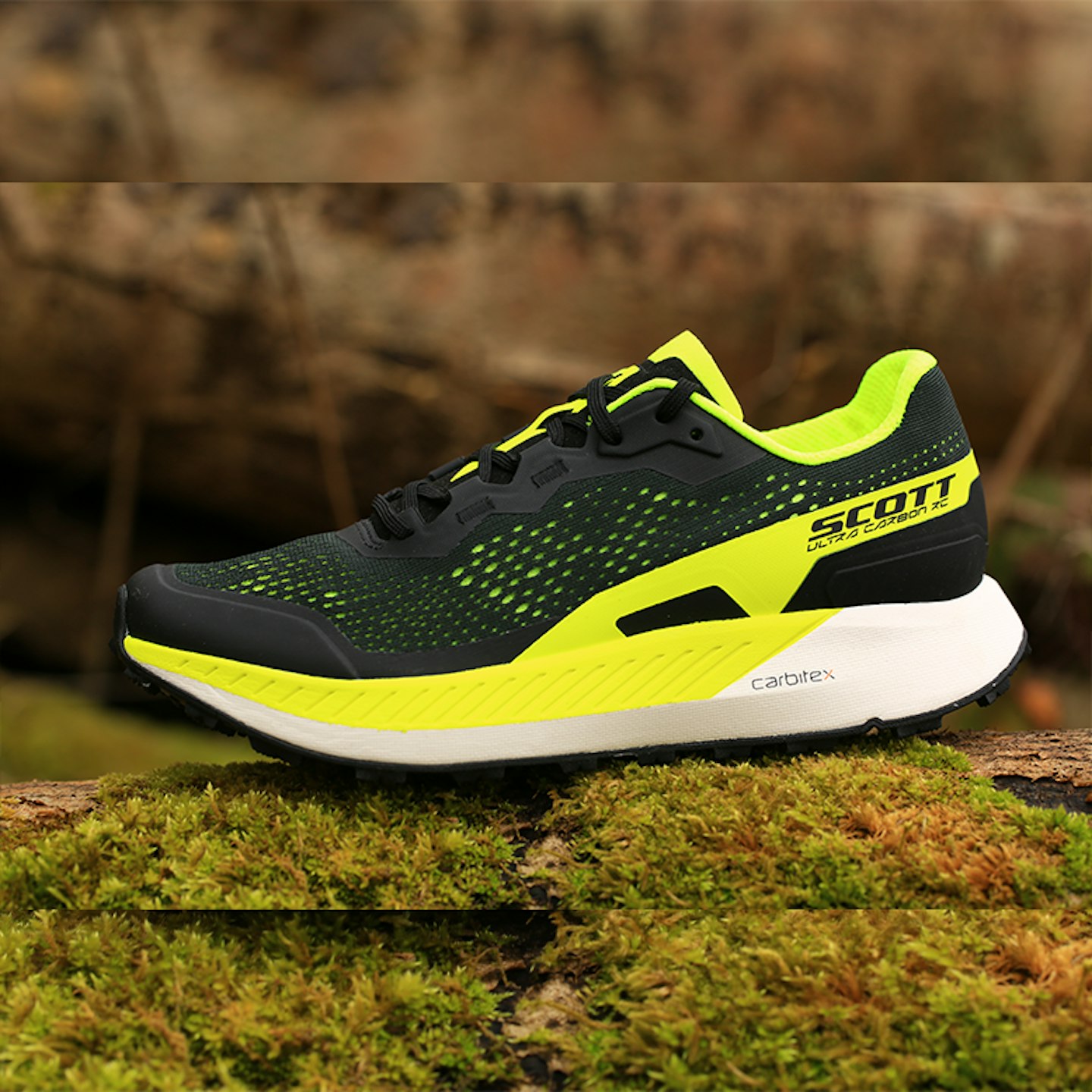Comfort is king when it comes to ultra trail running shoes. These are the shoes you should be able to rely on over long and arduous miles. The right shoe should make you feel like you can keep going forever, offering a blister-proof, supportive and lightweight ride.
First thing's first when you're looking to invest in any trail running shoe, you must have a good understanding of your own feet's anatomy and what structure of shoe works best for them.
Consider the width of your feet, if they're narrower than average then you'll want to look for brands who are known for a narrower fit, like Salomon.
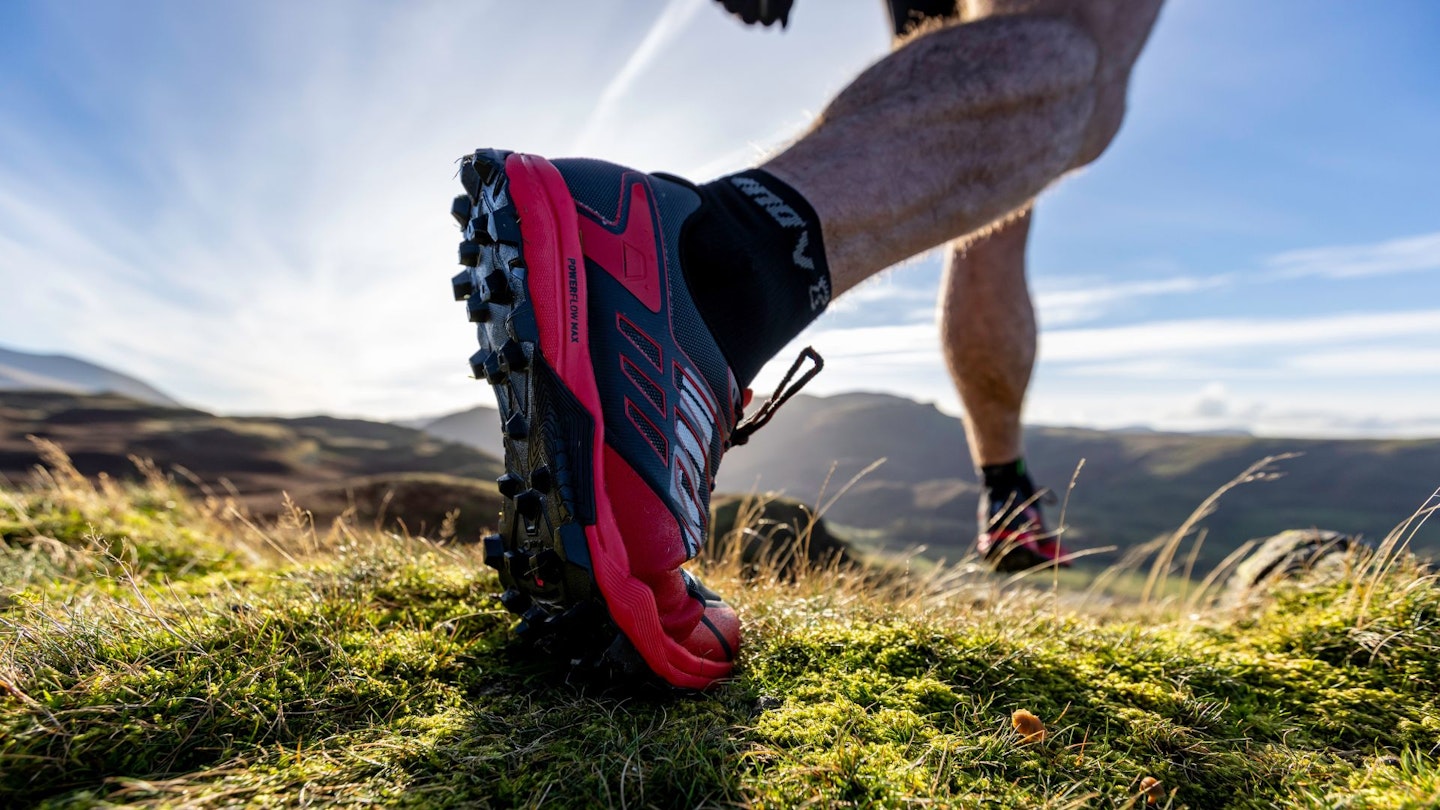
Or, for those with wider feet, a wider toe splay, or suffering with bunions, you'll probably want to reach for a shoe with more room in the toe-box to give your feet space to breathe. If your arches are high, you'll want to look at shoes with extra arch support, or even a stability shoe if you need some gait correction.
Once you understand what your feet need, you'll also need to consider features that optimise a trail running shoe for long distances. The first thing is comfort, like that you'd see in a road to trail running shoe, but you should also consider the level of support, breathability, quality of the outsole and the terrain it's aimed at, and the fit.
What are the best ultra trail running shoes of 2025?
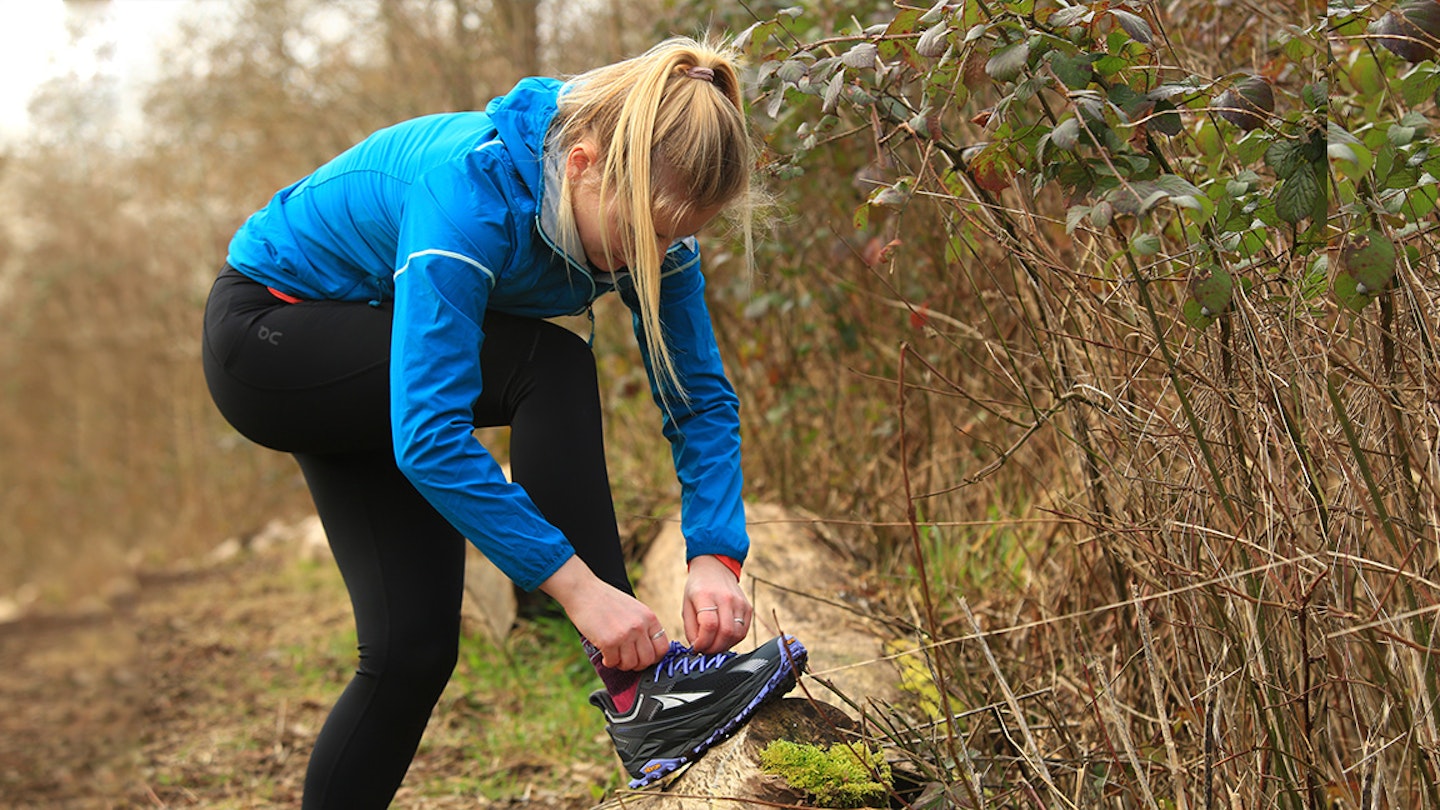
Scarpa Spin Infinity – Best in Test
Decathlon Evadict MT2 – Best Value
Saucony Endorphin Edge – Best carbon-plated ultra shoe
Dynafit Ultra 100 – Best supportive ultra shoe
We asked trail running's top shoe brands to submit their best long-distance trail running shoes. In this article we thoroughly test a range of them, including ones with max cushioning, with carbon-fibre plates, and with zero drop, sharing our honest and unbridled opinion on each.
Below, we take a look at the merits of a range of long-distance trail running shoes and test their features across different terrain and distances. This will help you decide on the best ultra running shoe for you. We've also explained key features to look out for in a pair of ultra trail running shoes.
How we tested the best ultra trail running shoes

The trail running footwear we test undergo thorough, objective, real-world testing. As soon as they arrive with us, they get allocated to one of our experienced gear testers who take them through their paces over a range of terrain and extended distances.
We consider multiple factors when testing and reviewing ultra trail running shoes, from the obvious, such as comfort and weight, to the less obvious and intricate, such as sustainability and durability.
The shoes in this group test were mostly put to work by ultra runner Kate Milsom in the hills of Bristol and beyond. A few also went to Milo and Chris (above), who run in the Surrey Hills and the Yorkshire Dales respectively. Click here for more info on how we test gear at LFTO.
Best ultra trail running shoes in detail:
Scarpa has a range of trail running shoes for all eventualities, but what the Spin Infinity focuses on is providing that necessary structure, comfort and stability for the longer distances.
The neutral, midweight trail shoe has a good level of structural support. The foot-wrapping overlay reaches up to the laces, which can be tightened to create a snug fit that hugs the foot in place, while a rigid heel counter offers more structural support. This is combined with a 4mm drop and slightly curved dual-density foam midsole, all of which come together to create a shoe with a good overall level of structure, without falling into the trap of becoming too stiff and unwieldy.
There’s a decent amount of padding along the heel and in the tongue, which Scarpa calls their ‘Adaptive Cushioning System’, it helps to keep the foot locked nicely in place, avoiding any heel slippage. The stack is also in that mid-range at 26mm, which offers ground protection without making you feel like you’re running in high heels.
Thanks to the panels of open mesh along the upper, the shoe manages to remain quite breathable in motion. There’s protection there too with the gusseted tongue and extended TPU toe bumper to protect from trail debris. A mesh pouch at the top of the tongue is there to tuck in laces, in theory this should prevent them coming undone mid-run.
Vibram Velox Cross lugs are 4mm in length, which means they can tackle a range of terrain but fare best along dry and less technical trails. Overall, the Scarpa Spin Infinity is a great all-rounder trail shoe that can hold up over those longer runs where you need that bit more support and comfort.
Check out the men's version here
Read our full Scarpa Spin Infinity review here
Pros
- Sturdy and supportive
- Enough cushion for longer distances
- Breathable and comfortable
- Grippy over range of terrain
Cons
- Not as agile/propulsive as some
| RRP: | £139.49 / $172.62 |
| Drop: | 4mm |
| Lug depth: | 4mm |
| Weight per shoe (UK5.5): | 268g / 9.45oz |
| Heel stack: | 26mm |
Decathlon says the Evadict MT2 is a mountain running shoe designed ‘for distances of 0 to 170km’. The successor of the MT, this newest version of the shoe prioritises stability and protection when running over rocky and rugged terrain.
The MT2 is a structured shoe with a fairly rigid upper and extra layers of protection up the sides and around the toes to ward off sharp trail debris. Naturally, a consequence of this is that the shoe is less breathable and a touch heavier than the really lightweight options on test.
The shoe’s camo-style outsole has a rockplate for further ground protection and fairly aggressive lugs. What we like about these is that the 8mm outer lugs jut out to the sides and do a great job of stabilising each footfall. We found they performed best over gravelly trails and loose terrain.
In terms of fit, the toe-box offers a good amount of room to accommodate feet swelling over long distances, though those with narrow feet may not get a completely locked-in fit. The cushioning in the tongue does feel a little overkill, but we found the mesh pouch for tucking away laces (also featured on the Scarpa Infinity Spin) to be a nice touch.
The MT2 achieves what it sets out to do, so if what you like in a long-distance trail shoe is that comfort and support, then this is a great affordable option. If you’re after a lightweight option, there’s Decathlon’s Race Ultra shoe or if it’s max padding you prefer, then take a look at the MT Cushion.
Pros
- Structured and protective
- Cushioned and comfortable
- Affordable and performs well
Cons
- May feel too rigid for some
| RRP: | £79.99 / $98.99 |
| Lug depth: | Up to 8mm |
| Weight per shoe (UK5.5): | 274g / 9.6oz |
| Drop: | 8mm |
Merrell MTL Longsky 2 Matryx
Merrell has listened to feedback and revamped the MTL Longsky 2, this time focusing on durability. Our tester put the Matryx version through its paces across muddy Surrey trails and rocky Lake District fells, and it impressed with excellent traction and stability.
The standout feature is the Kevlar-reinforced Matryx upper. This durable material excels on rugged, rocky trails but sacrifices flexibility. The upper doesn’t stretch, which may cause discomfort during long runs, but for technical, mountain-focused runs, the trade-off is worth it. Sizing is a bit tricky, but the snug fit provides great precision on tough descents.
Underfoot, the FloatPro midsole offers a soft yet responsive ride, with good ground feel without feeling too stiff. The 4mm drop encourages a natural gait, though it might not suit those who prefer more cushioning. The Vibram MegaGrip outsole shines on wet and loose surfaces, and the aggressive 5mm lugs provide great grip, although the exposed foam could wear down over time.
While the MTL Longsky 2 is less versatile than some competitors, its durability, traction, and mountain-ready design make it ideal for serious trail runners tackling technical terrain. If you’re after a tough, reliable shoe for demanding runs, this one’s a top contender.
**Read our full MTL Longsky 2 Matryx review here
**
Find the women's version here
Pros
- Highly durable upper
- Great traction on wet ground
- Surprisingly lightweight
Cons
- Upper material doesn't stretch
- Less versatile than other options
| RRP: | £155 ($194.63) |
| Weight: | 241g / 8.5oz (UK size 9) |
| Lugs: | 5mm |
| Midsole: | FloatPro 100% recycled TPU EVA foam |
| Outsole: | Vibram MegaGrip rubber |
| Stack: | 23.5mm (heel), 19.5mm (forefoot) |
| Drop: | 4mm |
The Dynafit Ultra Pro 2 is a game-changer for ultra-distance runners. Designed for marathon distances and beyond, it features a plush ‘Speed Light’ midsole that tester Rachel Collins described as “a game-changer” on Scotland’s Torridon trails. At 280g, it’s surprisingly nimble for a maximalist shoe, delivering all-day comfort on compact, undulating routes.
The upper combines breathable, debris-blocking mesh with durable TPU overlays, while the roomy toe box and supportive heel padding kept Rachel’s feet happy over long runs. The Vibram outsole impressed with its durability, but its shallow 3.5mm lugs were less effective on wet or technical terrain. For runners sticking to dry, friendly trails, it’s a reliable and forgiving companion.
The standout quick-lacing system earned praise for its simplicity and secure fit, making shoe changes a breeze. While it’s not a pick for mud or steep technical climbs, the Ultra Pro 2 excels at providing comfort and control for long-distance adventures. Perfect for runners easing into high-cushion footwear or looking to push their limits.
Read our full Dynafit Ultra Pro 2 review here
Pros
- Very comfortable cushioning
- Built to last
- A gentle introduction to a maximalist shoe
Cons
- Shallow lugs limit performance in wet and muddy conditions
| RRP: | £156.70 / $193.92 |
| Women’s sizes (UK) | 3-9 |
| Men’s sizes (UK) | 6-13 |
| Weight | 310g / 10.9oz men's, 270g / 9.5oz women's |
| Drop | 8mm |
| Lugs | 3.5mm |
The La Sportiva Bushido III is a masterclass in stability and grip, excelling on technical terrain. Our Scotland-based tester put these shoes through their paces on Arthur’s Seat and beyond, and they handled everything from rocky scrambles to slippery trails with confidence.
The updated FRIXION Red bi-compound outsole delivers exceptional traction, with aggressive multi-directional lugs and La Sportiva’s impact braking system to keep you secure on descents. The compressed EVA midsole provides lightweight shock absorption and trail sensitivity, though its minimal cushioning might not be to every ultra runner's taste. The breathable mesh upper impressed us with quick drying times and excellent ventilation, while the snug gusseted construction kept debris out. A wide-fit option is also available for those needing extra space.
Durability is a highlight here, with reinforced uppers and TPU overlays protecting the shoe from wear and tear. Sustainability gets a nod too, with recycled materials in the laces, insole, and mesh. Whether you’re tackling boggy paths or steep climbs, the Bushido III offers consistent performance and versatility.
If you prioritise stability and grip for technical trails, this shoe is hard to beat. While its lower-profile design may not suit all-day comfort seekers, it’s a fantastic choice for challenging runs and adventurous routes.
Read our full La Sportiva Bushido III review here
Pros
- Durable and versatile
- Supreme grip and traction on wide range of surfaces
- Extremely breathable
Cons
- Less cushioning than other trail shoes
| RRP: | £125.99 / $155.92 |
| Men's sizes (UK): | 6.5–12 |
| Women's sizes (UK): | 3–9 |
| Drop: | 6mm |
| Stack height: | 30mm / 24mm |
| Weight: | 250g / 8.8oz per shoe (UK 5) |
The Brooks Cascadia 18 promises “adaptable stability,” and after testing it over a few tricky trail races, we’re inclined to agree. While it won’t win any awards for agility or speed, this shoe shines on rugged terrain where traction, cushioning, and durability take priority.
What stands out most is the redesigned midsole, which sinks the footbed deeper into the DNA Loft v2 cushioning and flexible rock plate. This setup provides excellent shock absorption without compromising ground feel. Over rocky sandstone and slippery boulders, the Cascadia felt stable and planted, with multi-directional lugs offering exceptional grip on both ascent and descent. The TrailTack Green Rubber outsole performed brilliantly, adapting to uneven terrain while resisting mud build-up.
The fit is generous, but dropping half a size gave our tester a snug and secure hold, particularly at the heel. While the upper’s perforated mesh was breathable and tough enough to fend off scuffs, the shoe’s chunky weight was noticeable on steep climbs. That said, it felt reassuringly protective on hard, unpredictable ground. In all, if you value comfort and confidence over speed, the Cascadia 18 is great pick.
**Find the women’s version here
**
Read our full Brooks Cascadia 18 review here
Pros
- Outstanding traction
- Excellent stability
- Toughened toe-box
- Reasonably flexible
Cons
- Its chunkiness means it’s fairly hefty
- Not as agile as sleeker competitors
| RRP: | £135 / $167.07 |
| Women’s sizes: | 3-10 |
| Men’s sizes: | 6-14 |
| Weight: | 322g / 11.3oz (men’s UK 8½ ) |
| Drop: | 8mm |
| Stack height: | 33mm heel, 25mm toe |
| Lugs: | 4.5mm |
| Versions: | Regular, wide |
Saucony’s Endorphin Edge is a very focussed and lightweight trail shoe. It’s intended for mixed terrain, but leans towards hard-packed trails, which is where you get the most bang for your buck with the carbon plate.
The midsole has a lot going on. Saucony’s Speedroll design aims for maximum forward propulsion, which is paired with heaps of foam cushioning. The result? A rather tall, neutral shoe, with a 35mm/29mm stack height.
Sandwiched in there is the Carbitex MonoFlex carbon fibre plate. The MonoFlex plate manages to be stiff in one direction for foot protection and to give propulsion uphill, also with lateral flex to turbocharge your running efficiency and give you downhill stability. Big tick.
The 4mm lugs and PWRTRAC outsole can cope with muddy terrain, but grip is definitely best on the more tightly-packed and flat trails.
The light and tightly-woven mesh upper is incredibly breathable and keeps debris out well. However, it’s very flexible, which appears to result in the shoe lacking stability on really technical trails.
**Check out the men's version here
**
Read our full Saucony Endorphin Edge review here
Pros
- Lightweight and breathable
- Propulsive midsole and carbon plate
- Roomy toe-box
- Great for long-distance comfort
Cons
- Expensive
- Less at home on soft mud
| RRP: | £200 / $247.50 |
| Weight per shoe (UK5.5): | 224g / 7.9oz |
| Lug depth: | 4mm |
| Drop: | 6mm |
| Heel stack: | 35mm |
With long-distance in the name (LD), we had high hopes for the comfort and durability of the Arc’teryx Norvan LD 3. Since the LD2, these shoes now have a higher stack, no rock plate, a lower drop at 6mm, and a different upper material called Cordura.
Pulling on the shoes for the first time, we immediately felt pretty cool in the minimalist monochrome colourway. Arc’teryx says these shoes are designed to be supportive and lightweight for long runs, and they certainly are light at 230g for a UK5.5.
As expected, the Vibram Megagrip outsole performed well over a variety of terrain, with 4mm lugs able to dig into and hold traction even in softer mud. Stability is pretty good, there’s an internal foot wrap which acts as an overlay and works with the laces and slight padding on the heel to lock the foot in place. A neat little lace garage keeps them out the way.
The dual-layer Cordura mesh upper keeps the feet cool by allowing heat and sweat to escape, while keeping out debris. Arc’teryx says that the toe-box is designed to allow for toe-splay. It was plenty roomy for us, but we wouldn’t call it a large toe-box. There’s also no wide option available in this model.
**Find the women's version here
**
**Read our full Arc'teryx Norvan LD 3 review here
**
Pros
- Lightweight and comfortable
- Good stability and grip
- Stylish
Cons
- Not as agile as others
- Relatively expensive
- Monochrome colourways no longer appear available
| Heel stack | 29mm |
| Drop | 6mm |
| Lug depth | 4mm |
| Weight per shoe (UK5.5) | 230g |
With a stack height of 33mm, the Olympus 5 may be zero drop, but it’s certainly not minimalist. Altra says the Olympus 5 is their most cushioned trail running shoe, the chunky EGO MAX compression moulded foam midsole feels plush and protective underfoot.
There’s also zonal cushioning around the top of the heel collar and a slight injection along the gusseted tongue. This results in a nice, locked-in feel when running. Plus, the wide-set laces are extremely reflective in low lighting, an unexpected bonus. However, we did find that though the tongue was nice and thin, it sat very rigidly along the foot and dug into the ankle, rather than moulding to the shape of the foot as we’d expect.
The main attraction for Altra fans is the wide toe-box, the resulting alien-esque look sets the shoes apart from most other trail shoe brands we’ve tried. Altra call this ‘Original FootShape fit’, a concept around which they’ve built their entire identity. The larger toe-box aims to allow the toes to naturally spread out, for better comfort and stability.
While the toe-box does feel larger than your normal trail shoe, we did feel our toes touching the end of the shoe from time to time. This fifth version of the Olympus seems to run a little smaller in sizing and shorter in length to its predecessor, we’d size up by .5 next time.
We have no complaints when it comes to the super grippy Vibram Megagrip outsole, which held its own in sloppy mud, loose rocky trails, and over wet rock. If you like to double up on the protection by strapping on gaiters, you can do this via the heel tab. The upper’s also nice and breathable, with plenty of aeration to keep us cool over longer runs.
Pros
- Well-placed cushioning
- Grippy lugs
- Wide toe-box
- Well built
Cons
- Sizing runs a little small
- Tongue digs into ankle
- Zero drop won't be for everyone
| Heel stack | 33m |
| Drop | 0mm |
| Lug depth | 5mm |
| Weight per shoe (UK5.5) | 275g |
Donning the Craft CTM Ultra Carbon race shoes for the first time, the first thing that hit us was how agile and fast they felt. There are many factors at play here, but we like how the silhouette of the shoe shapes to the contours of the foot while still providing enough room at the toe, a set-up which Craft calls their anatomical racing fit.
The whopping 40mm stack midsole has five layers built into it, which Craft has named the 'Ultra Platform' and from the feel of the shoe, this is where the majority of the weight sits. At 300g per shoe (UK5.5), it’s not uber light by any standards, but somehow the CTM still manages to feel nimble and fast in action.
Within the platform wedge sits the outsole, carbon plate, midsole foam, popcorn-foamed insole and one-piece mesh upper. The springy ridges of the insole mould nicely to the foot, while the mesh upper feels very thin and ventilated. This all comes with an aggressive 10mm drop, which we found to be a good fit for our relatively high arches, but it’s worth noting this won’t suit all feet, especially runners who prefer a smaller drop and greater ground feel. The CTM does have some cushioned support in the heel collar, with the midsole jutting out at the back for extra stability.
Like all carbon shoes, the CTM performs best over hard-packed terrain where the carbon plate can really come into its own. The rubber traction outsoles with 5mm lugs can cope with mud, but as with any trail shoe, the really soft stuff will require more aggressive grip seen more on winter trail running shoes.
Pros
- Feels fast and propulsive
- Shock-absorbing midsole
- Thought-out build
Cons
- Heavier than some
- Less affordable than others here
| Heel stack | 40mm |
| Drop | 10mm |
| Lug depth | 5mm |
| Weight per shoe (UK5.5) | 300g |
The Dynafit Ultra 100 stands out in look and features, it’s not your traditional trail running shoe. A touch heavier and with a sizeable stack, the Ultra 100 is made specifically for longer distances off the beaten path, where cushioning and support are your number one priority.
With this in mind, we can understand the appeal of these sturdy kicks, which have a good deal of protection from the mesh laces cover to the large toe-bumper and chunky stack raising you off the ground and out of the way of any sharp trail debris. The Pomoca outsole and lugs fared best on dry and hard trails, especially thriving over loose scree and gravel paths, while offering less traction over softer muddy sections.
In motion, the 261g weight (UK5.5) of the Ultra 100 is noticeable, but not enough to slow down your run significantly. What’s also apparent is the nice injection of cushioning around the heel and midsole, which helps keep the foot locked in place without causing any rubbing.
The neutral shoe has a 6mm drop which should suit most feet. Dynafit says a precision fit should allow for ‘plenty of blood flow to prevent the foot from swelling on long runs’. Going half a size up as advised, the shoe felt both snug and supportive, while having enough room for the toes to splay.
Pros
- Very sturdy and supportive
- Protective over rocky terrain
Cons
- Feel a little clumpy
- Not for extreme mud
| Heel stack | 32mm |
| Drop | 6mm |
| Lug depth | 4mm |
| Weight per shoe (UK5.5) | 261g |
The MTL Skyfire 2 is the lightest trail running shoe Merrell has ever made. When on, the low-volume shoe almost feels more like a sock, but in the best way possible, with one of our UK5.5 shoes weighing a tiny 171g. The high-tensile mesh and TPU upper is one of the slimmest and most breathable we’ve seen - so much so that a passing breeze easily permeates the upper. Needless to say, there was no overheating on the trails in these!
A modest 25mm stack means the feet sit relatively close to the ground, providing a high level of ground feel when running. Free from the entrails of a maximalist shoe, we felt a better precision and connection to the twists and turns of the trail.
Protecting the soles of the feet from any sharp bumps in the trail is Merrell’s ‘FlexPlate’ rockplate, which is sandwiched between two dual-density FloatPro Foam midsole layers. Doing away with the stiffness of some carbon plates, this full-length plastic-composite plate adds structure and stability to the shoe, while remaining flexible and relatively responsive.
The Skyfire 2 excels best during fast runs, though due to the light cushioning, the impact was more noticeable when doing sustained efforts over hard-packed terrain. The Vibram MegaGrip outsole has been made custom to the Skyfire 2, the thin spider web design sports grippy 6mm lugs.
If you’re after a fast and precise trail shoe with excellent ground feel, the Skyfire 2 is hard to beat for up to the marathon distance. But for those who prefer a touch more protection and cushioning, take a look at the other less minimal shoes in this round-up.
**Read our full Merrell MTL Skyfire 2 review here
**
Check out the men's version here
Pros
- Extremely light and breathable
- Agile and fast
- Good ground feel and precision
Cons
- Less structural support and cushioning than some
| Heel stack | 25mm |
| Drop | 6mm |
| Lug depth | 6mm |
| Weight per shoe (UK5.5) | 171g |
Scott pens the Scott Ultra Carbon RC as their 'most technological trail racing product to date' due to its in-built carbon plate and rocker shape. It’s made to excel on easy and rolling (read, hilly) trails in a racing environment where speed is of the essence.
Let’s start with the most exciting feature, the Carbitex GearFlex carbon plate is made to be pliable during easy running, while simultaneously having the ability to become stiffer and thus, more responsive to an increase in speed. The plate has a ‘swallow tail’ shape which splits towards the heel to allow for more lateral flex, while the rocker is intended to encourage a more dynamic running gait for better running economy. Though the weight of the shoe is on the heavier side for carbon kicks, the propulsion caused by the rocker and plate really helps minimise the effects of this.
In action, it’s obvious the RC is a good-quality build, the first thing that hit us was how sturdy and supportive it felt. There’s a medium amount of cushioning which is most evident around the collar and dual-density midsole foam that has a 25mm stack, while the 5mm drop makes this a neutral yet supportive-feeling shoe. The downside to this being that the shoe felt a little lacking in flex and agility.
The outsole and lugs provide traction along a range of terrain, while the engineered mesh upper has an extra injection of protection from a TPU layer which extends out from the toe bumper. While this may equal brownie points for durability in the long run, we felt it weighed down the 292g (UK5.5) shoe and made it feel less breathable in action.
Pros
- Lots of stability and structure to the shoe
- Rocker aids momentum
- Bright colourways
- Durable feel
Cons
- Not as agile as others
- Feels a little too rigid
- Less affordable than others
| Heel stack | 25mm |
| Drop | 5mm |
| Lug depth | 3mm |
| Weight per shoe (UK5.5) | 292g |
What to look for in a long-distance running shoe
The first thing is comfort, this can be seen in the level of cushioning, the materials used, and those little features that make your run smoother.
You should also think about how supportive the shoe is, does it offer good support in the arches (if you need that), heel, and overlays? What is the density and durability of the midsole foam?

Most of all, the fit needs to be right for you. Fit could depend on many aspects such as: placement of cushioning, height of the heel collar, how the tongue sits, the width of the shoe, the size of the toe-box, and more. If these terms are confusing, take a look at our trail running shoe buyer's guide to better understand key features of a run shoe and how they fit.
About the author
We recommend you wear your shoes around the house before getting them muddy, to see whether the fit and level of support is right for you. Most shoe retailers will have a refund policy, so if you don't get on with them, you can send them back and find a pair that works for you.

Kate Milsom is Digital Content Writer for Live For The Outdoors, within which she specialises in trail running content. In her career as a specialist sports journalist, Kate has worked with industry-leading titles including 220Triathlon, Cycling Plus, Road.cc and Cyclist. Prior to this, Kate studied English Literature and French at univeristy, then got the outdoors bug and never looked back.

